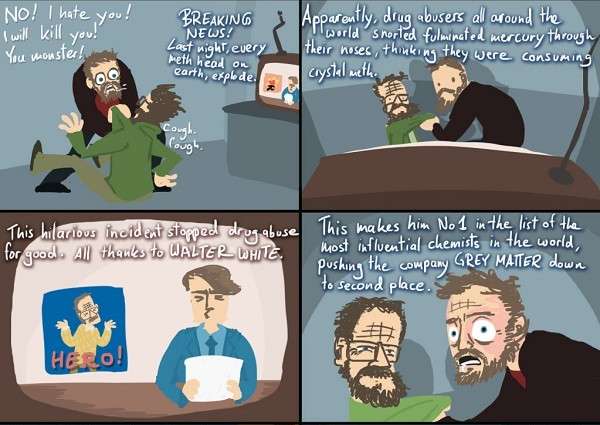
Kleiner Ausschnitt der letzten Folge von Breaking Bad, wie Marius sie sich vorstellte.
| Date | About | Titel | From |
| 14.03.2012 | Wes Anderson | A dramaturgical walk through Hotel Chevalier | Claudio |
| 14.10.2013 | Vince Gilligan | What's so Freaking Good about Breaking Bad? | Claudio |
In den USA lief vor kurzem die vorletzte Folge von Breaking Bad. Die Quoten sind besser denn je. Was ist das Geheimrezept der Serie? Und ließe es sich irgendwie nachkochen?

Kleiner Ausschnitt der letzten Folge von Breaking Bad, wie Marius sie sich vorstellte.
Walter White, die Hauptfigur von Breaking Bad, kocht das beste Crystal Meth im ganzen Land. Es ist so gut, dass er sich innerhalb weniger Monate vom überbegabten Chemielehrer in einen Drogenboss verwandeln konnte. Natürlich sind jetzt alle hinter seiner einmaligen Rezeptur her. Doch Walter White weiß: Nicht nur das richtige Rezept ist entscheidend, sondern auch die richtige Arbeitsweise.
Vince Gilligan, der „Creator“ von Breaking Bad, hat die beste Serie der Filmlandschaft entwickelt. Sie ist so gut, dass er sich innerhalb weniger Jahre vom überbegabten Akte-X-Autor in einen Medienstar verwandeln konnte. Natürlich sind jetzt alle hinter seiner einmaligen Rezeptur her. Der amerikanische Fernsehsender AMC hat vor kurzem einen Spin-Off angekündigt. Ein mexikanischer Remake ist bereits in Vorbereitung. Und auch hierzulande kündigte der ZDF-Programmdirektor Norbert Himmler kürzlich vollmundig an, man plane für 2014 „Breaking Bad auf deutsch.“
Das alles liegt daran, dass Breaking Bad mindestens genauso süchtig macht wie die Droge, um die sich in ihr alles dreht. Und daran, dass Vince Gilligan sich absolut sicher ist, dass nach der 5. Staffel Schluss sein soll. Was bleibt den Sendern also anderes übrig, als verzweifelt nach Ersatzstoffen zu suchen?
Was aber ist das Erfolgsgeheimnis von Breaking Bad
Im Internet streiten sich Laien und Profis über genau diese Frage. Man findet umfangreiche Listen, ebenso wie universell einsetzbare Kalendersprüche („It constantly pushes its own boundaries.“)
Unter der Zutatenliste gibt es einige wiederkehrende Kandidaten: Die starke Prämisse, der konsequent schwarze Humor, die abgründige Figurenzeichnung und auch der hohe Produktionswert (obwohl der mit ca. 3 Millionen Dollar pro Folge nicht unbedingt rekordverdächtig ist).
Die Zutaten sind natürlich enorm wichtig. Und doch wird meiner Meinung nach ein ganz entscheidender Punkt systematisch übersehen: Das unnachahmliche Gespür für Rhythmus.
Als ich die Pilotfolge 2009 zum ersten Mal sah, hatte ich zwei Gedanken. Der erste war: „Man, erzählen die schnell.“ Und der zweite: „Man, lassen die sich viel Zeit!“
Das hört sich widersprüchlich an, aber genau so war es. Innerhalb von nur 90 Minuten habe ich miterlebt, wie ein ohnehin schon bemitleidenswerter Chemielehrer eine Krebsdiagnose bekommt, über seinen Schwager Verbindungen ins Drogenmillieu aufbaut, mit einem seiner Ex-Schüler einen Wohnwagen kauft und darin im großen Stil Cystal Meth kocht, sich mit Cops und Druglords in eine schier auswegslose Situation hineinmanövriert - und am Ende doch noch den Kopf aus der Schlinge zieht.
Und gleichzeitig hatte ich miterlebt, wie eben dieser Chemielehrer minutenlang nichts anderes tut, als auf seinem Stepper zu marschieren und Streichhölzer in seinen abgehalfterten Pool zu werfen.
Kurzum: Ich kenne keine Serie, die so genau weiß, wann sie einen stillen Moment über Minuten hinweg ausdehnen darf – und wann sie eine furiose Szene frühzeitig beenden kann. Falls es so etwas gibt wie ein absolutes „Gespür für Rhythmus“, dann hat Breaking Bad genau das.
Doch wie kriegt man das hin?
Liegt es wirklich einfach nur am Genie der amerikanischen Autoren (auch Vince Gilligan arbeitet natürlich in einem Team)? Wäre ein – wie auch immer geartetes – deutsches Imitat also schon allein deshalb von vornherein zum Scheitern verurteilt, weil man keine ähnlich talentierten Autoren auftreiben kann?
So leicht ist es glaube ich nicht. Anders als beim absoluten Gehör handelt es sich beim „absoluten Gespür“ meiner Meinung nach nicht um eine angeborene Fähigkeit. Vielmehr braucht man: Viel Erfahrung, viele Freiheiten, viel Arbeit, viel Zeit, und vor allem: Viel Zeit zum Überarbeiten.
In dieser Ausgabe von Close Reading will ich deshalb eine zunächst ziemlich unscheinbare Szene aus der Pilotfolge von Breaking Bad genauer unter die Lupe nehmen. Sie ist ruhig, handlungsarm und fast völlig dialoglos. Und doch ist es eine „Wegscheideszene“, denn sie zeigt genau diejenigen Sekunden, in denen sich Walter White entscheidet, seinem alten Leben good-bye zu sagen.
Die Streichhölzer im Pool
Auf YouTube findet sich leider nur eine verfälschte Version dieser Schlüsselszene (es wurden andere Szenen dazwischen montiert und ein neuer Soundtrack gewählt). Deshalb muss ich sie hier beschreiben. Sie folgt direkt auf die Szene, in dem Walt mit dem denkwürdigen Satz „Fuck you – and your eye brows!“ seinen Zweitjob in der Waschanlage gekündigt hat:
Blaue Morgendämmerung. Walter White sitzt im Morgenmantel vor seinem Pool. Beide – Walt und Pool – haben schon mal bessere Zeiten gesehen. Auf dem Tisch neben ihm eine einsame Bierflasche. Wahrscheinlich hat sie nicht geholfen. Walter entzündet ein Streichholz und betrachtet die Flamme, die zuerst stolz auflodert, dann aber schnell zusammenschrumpft. Ehe sie erlischt wirft Walter das Streichholz mit einer müden Handbewegung in den Pool. Sofort lässt er das nächste Hölzchen über die Reibefläche gleiten. Diesmal betrachtet er die Flamme etwas genauer (die Handkamera wechselt in eine nahe Einstellung), doch auch dieses Streichholz landet im Pool. Das gleiche geschieht mit dem dritten Streichholz – nur dass die Handkamera diesmal die Wurfbewegung aufgreift, kurz auf den Pool schwenkt, und dann wieder bei Walter landet, der mit den Fingern bereits nach dem vierten Streichholz sucht. Nun aber hält Walt inne und steckt es wieder zurück in die Schachtel. Er lehnt den Kopf zurück, schaut kurz in den sich schwach rötenden Himmel. Dann fällt sein Blick auf den Beistelltisch, auf dem – wir erkennen es erst jetzt – ein Telefon liegt. Walter tauscht Streichholzschachtel mit Telefon und ruft seinen Schwager Hank an. Er hat sich entschieden, auf die dunkle Seite zu wechseln.
Ich beschreibe das deshalb so ausführlich, weil ich zeigen will, wie viel Zeit sich die Serie nimmt, um diesen entscheidenden Moment wirken zu lassen. Noch Sekunden zuvor hat Walt seinen Chef zur Sau gemacht und Produkte aus dem Verkaufsregal geschleudert. Doch hier ist er ganz bei sich und seiner auswegslosen Situation. Und auch wir sind ganz bei ihm. Wir achten auf jedes Detail. Wir spüren die Anspannung. Und das, obwohl doch angeblich auf diesen kleinen TV-Bildschirmen nicht genug Platz ist, um „episch“, oder „kinohaft“ zu erzählen.
Wieso gelingt diese Szene so gut?
Wieso glauben wir einerseits zu spüren, was Walt denkt – und finden ihn gleichzeitig auf faszinierende Weise unergründbar?
Zunächst einmal muss man vorausschicken, dass diese Szene in einer vorhergehenden Szene gut vorbereitet wurde. Knapp 15 Minuten zuvor sahen wir Mr. White dabei zu, wie er einer typisch indifferenten Schulklasse vermitteln wollte, was an Chemie so faszinierend ist. Da sagte er: „Chemistry is the study of change. Electrons change their energy levels. Molecules change their bonds. Elements – they combine and change into compounds. Well that's – that's all of life, right? It's the cycle, it's solution, dissolution – just over and over and over.“
Während Walt sich in diesen Monolog hineinsteigerte, bemerkten wir, dass er mehr mit sich selbst sprach als mit seinen Schülern. Die Flamme des Bunsenbrenners, an der er diesen Gedankengang demonstrierte, loderte vor seinem Gesicht Gesicht. Ganz ähnlich wie die Flamme des Feuerzeugs in der entscheidenden Szene 15 Minuten später.
Ganz ohne Worte begreifen wir also, was in Walters Kopf vorgeht, als er da alleine am Pool sitzt. Er denkt über die Veränderungen des Lebens nach. Die Veränderungen, die ihn einst, als renommierten Chemiker, endlos faszinierten, und die nun, nach seiner Krebsdiagnose, in seinem eigenen Körper stattfinden. Er entscheidet sich, diesen Veränderungen nicht länger nur zuzusehen. Er entscheidet, selbst etwas zu verändern.
Ganz simpel und naheliegend, eigentlich. Wussten die Macher von Breaking Bad von Anfang an, dass es nur so funktionieren kann? War es ihr angeborenes Talent, von dem die Amerikaner so viel zu haben scheinen und wir Deutschen – unserem Fernsehprogramm nach zu urteilen – so wenig?
Oder haben sie es sich im Gegenteil hart erarbeitet?
Ein Blick in eine frühere Fassung des Pilotdrehbuchs kann hier Abhilfe verschaffen. Zum Glück findet man derartiges ja schnell im Netz. In dieser Fassung finden sich jedenfalls einige sehr aufschlussreiche Unterschiede zur letztendlich abgedrehten Folge.
Möglichst kurz zusammengefasst: In der früheren Fassung flippt Walt beim Car Wash nicht aus, sondern verlässt lediglich wortlos das Gebäude.
Walt fährt nachhause. Er ist sonderbar apatisch. Er wird es den gesamten Abend über bleiben.
Zuhause angekommen fragt ihn seine Frau Skyler über seine Kreditkartennutzung, nicht aber über sein Wohlbefinden (diese Szene findet sich auch im fertigen Piloten, jedoch an anderer Stelle). Das Gespräch wird von dem Geknatter eines Maschinengewehrs unterbrochen – Walter Jr. schaut im Nebenzimmer Scarface.
Es läuft gerade das große Finale, in dem Al Pachino sein eigenes Himmelfahrtskommando noch mit ein paar Ausrufezeichen versieht. Walt redet kurz mit seinem Sohn, schaut dann gedankenverloren auf den TV-Bildschirm.
Beim nächsten Schnitt klingelt sein Wecker. Walt steigt im Morgengrauen vor allen anderen aus dem Bett und macht Morgensport auf seinem Stepper. Er steppt sich in Rage, bis der Stepper zerbricht. Walt murmelt zu sich selbst „Two years“ - die ungefähre Zeit, die er noch zu leben hat. Im nächsten Bild sitzt er allein in der Küche und wählt Hanks Nummer.
In dieser Drehbuchsequenz hat Walt letztlich die gleiche Entscheidung getroffen wie im fertigen Film. Auch diese Szenen sind keineswegs gehetzt, sondern einfühlsam geschrieben. Man hätte es dabei belassen können. Aber dann wären wir nicht so nah an Walts Innenleben herangekommen. Anstatt seine Gedanken aus seinem Gesichtsausdruck im Licht der Streichholzflamme ablesen zu dürfen hätten wir dabei zuschauen müssen, wie Scarface seine Gedanken mittels Maschinengewehr in Walts Kopf einhämmert.
Es wäre auch gutes Fernsehen gewesen. Vielleicht sogar sehr gutes. Aber kein brillantes.
Wie kam es zu diesen Änderungen, wie kam es zu der „Entdeckung“ der Pool-Szene? Natürlich kann man darüber nur mutmaßen. (Schließlich wissen wir nicht einmal, wie viele weitere Fassungen zuvor und danach geschrieben werden mussten.) Aber es scheint offensichtlich, dass man schneller auf den Punkt kommen wollte. Die Sequenz musste einfach kürzer werden. Schließlich gibt es im Fernsehen strike Zeitvorgaben.
Doch derartige Kürzungen gelingen natürlich nur, wenn man es schafft, einen guten Ersatz zu finden. Wenn man ein einziges Bild findet, das in der Lage ist, alle vier anderen zu ersetzen. Ein Bild, das Walts gesamte Entwicklung einfängt – und zwar, indem es geschickt einige Lücken lässt, und gleichzeitig geschickt an zuvor Gesehenes anknüpft.
Genau das ist es, was die Streichholz-Idee leistet. Hat man diese Idee erst einmal gefunden – diese eine Idee, die Großes im Kleinen erzählt – dann, und nur dann, kann man es sich auch wieder erlauben, ihr die entsprechende Zeit zu gewähren, damit sie sich voll und ganz entfalten kann.
Genau das ist es, was mir beim ersten Zuschauen den paradoxen Eindruck einer langsamen Hetzjagd vermittelte.
Was kann man aber tun, um auf derartige Ideen überhaupt erst einmal zu kommen? Die Schritte, die hier wie gezeigt zwischen der Drehbuchfassung und der verfilmten Szene liegen, zeigen beispielhaft auf, dass kommerzieller Druck (die Sendelänge) nicht zwangsläufig der erzählerischen Qualität (einfühlsames, präzises Erzählen) schaden muss. Im Gegenteil, die beiden Faktoren scheinen sich geradezu gegenseitig zu befruchten - wenn die Voraussetzungen stimmen.
Diese Voraussetzungen sind eigentlich altbekannt, scheitern allem Anschein nach hierzulande jedoch noch immer an der Umsetzung. Es muss eine enge, vertrauensvolle Zusammenarbeit zwischen Produzenten, Autoren und „Creator“ bestehen. Der „Creator“ braucht die nötigen Freiheiten. Die Autoren brauchen den nötigen Austausch – möglicherweise eben den oft zitierten „writer's room“. Und alle gemeinsam brauchen sie die nötige Risikobereitschaft, neue Wege zu beschreiten.
So kann ein kreatives Millieu entstehen, in dem tatsächliche Originalität heranwächst. Und diese Originalität muss nicht immer aus dem ganz großen Wurf bestehen – sie kann, wenn es um einzelne Szenen geht, auch in ganz simplen, aber einfühlsamen Einfällen liegen.
In einem Interview mit der FAZ (leider nicht online verfügbar, hier aber folgerichtig umschrieben) erzählte Norbert Himmler von seinem Besuch in einem Serienlabor von HBO. Er war fasziniert davon, wie viel Vertrauen der Sender der Autorin und Darstellerin Lena Dunham bei der Produktion der Serie Girls entgegen bringt. Seine Schlussfolgerung: „Ich glaube, so muss im fiktionalen Bereich die Beziehung zwischen einer guten Redaktion und einem guten Produzenten aussehen.“
Dass er den Autoren aus dieser Gleichung - anscheinend ohne es überhaupt zu bemerken! - herauskürzte, ist allzu bezeichnend. Ob unter dieser Prämisse wirklich eine gute Serie entstehen, kann bleibt deshalb (noch) zu bezweifeln.
Eins nämlich weiß Vince Gilligan genau so gut wie seine Kreation Walter White: Ohne die richtige Arbeitsweise ist auch die beste Rezeptur nichts wert.
Dieser Beitrag wurde ursprünglich im Freitag veröffentlicht (22.09.2013).
A dramaturgical walk through Hotel Chevalier (Wes Anderson)Watch the film on vimeo
„Only a fool tells all he knows. A wise man keeps his mouth shut.“
In this analysis, I will be the fool and Wes Anderson's short film Hotel Chevalier will be the wise man. I will be the one trying desperately to discern why Hotel Chevalier is so fascinating to me. And Hotel Chevalier will keep holding back some of its secrets, and will thereby – no matter how much I try to take it apart – not let itself be nailed down completely.
I will be taking you step by step through the reactions and expectations I have when watching the film. And I've watched it more than once. (The short film was released and screened as a prelude to Darjeeling Limited but I will take Hotel Chevalier completely on its own because – well, the film just works so perfectly well on its own).
So let's take a close look.
The very first scene is a simple figure shot of the reception: We're introduced to the setting – a nice
looking cozy French hotel. The phone is ringing and the concierge takes his time to pick it up.
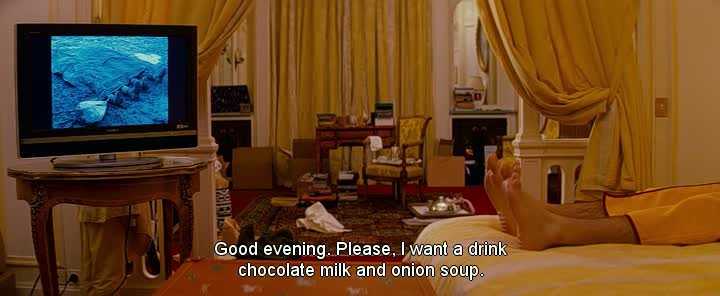 Then we switch right into a very interesting shot: All we see of the caller (Mr. Whitman) are his feet and
legs. A much larger portion of the frame is devoted to the cluttering mess Mr. Whitman has made of his hotel
room. From this alone, we gather a bunch of information, which will later be confirmed: That he's living
in this room on his own, that he's been living there for quite a while, that he doesn't have much to do
outside of the hotel room etc. An even more startling detail is the TV-Set, which displays what looks
like a black-and-white war documentary. The corpses framed here are covered with a blanket with their boots
sticking out at the end. This mirrors Mr. Whitman's own two feet and quite possibly his own inner feeling.
Then we switch right into a very interesting shot: All we see of the caller (Mr. Whitman) are his feet and
legs. A much larger portion of the frame is devoted to the cluttering mess Mr. Whitman has made of his hotel
room. From this alone, we gather a bunch of information, which will later be confirmed: That he's living
in this room on his own, that he's been living there for quite a while, that he doesn't have much to do
outside of the hotel room etc. An even more startling detail is the TV-Set, which displays what looks
like a black-and-white war documentary. The corpses framed here are covered with a blanket with their boots
sticking out at the end. This mirrors Mr. Whitman's own two feet and quite possibly his own inner feeling.
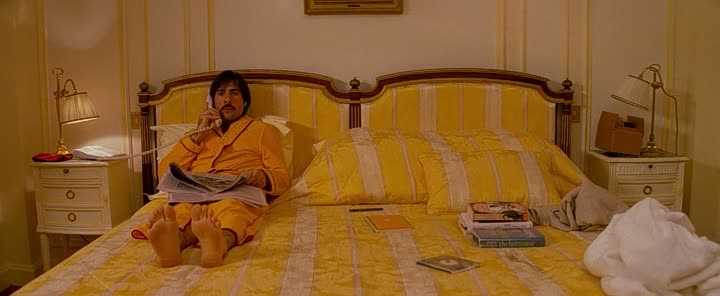 In the next shot we see Mr. Whitman for the first time. He has adapted quite well into the surroundings of
his hotel room: the bathrobe he is wearing does not set itself apart from the color of the bedsheets. Our
notion that he's living by himself is affirmed by the way he's laying in his bed on one side, while the
other side is covered with books, a notebook, and a CD: these objects are laying around where normally,
his partner / lover may be lying. He looks pretty lonely and unoccupied. What's even more telling is the
way he's ordering his grilled cheese sandwich: He's trying to order in French – and has probably done so
plenty of times – but struggles with the one word that may change from order to order. In short:
He's working on adapting to his (French) surroundings, but cannot quite manage
to hide his (American) origin.
In the next shot we see Mr. Whitman for the first time. He has adapted quite well into the surroundings of
his hotel room: the bathrobe he is wearing does not set itself apart from the color of the bedsheets. Our
notion that he's living by himself is affirmed by the way he's laying in his bed on one side, while the
other side is covered with books, a notebook, and a CD: these objects are laying around where normally,
his partner / lover may be lying. He looks pretty lonely and unoccupied. What's even more telling is the
way he's ordering his grilled cheese sandwich: He's trying to order in French – and has probably done so
plenty of times – but struggles with the one word that may change from order to order. In short:
He's working on adapting to his (French) surroundings, but cannot quite manage
to hide his (American) origin.
Anyway, all this is – or has become – his normal mode of life. A mode which will be interrupted by the very
next phone call. Expecting the concierge, Mr. Whitman picks up the phone in a relaxed way – but then he hears a female voice.
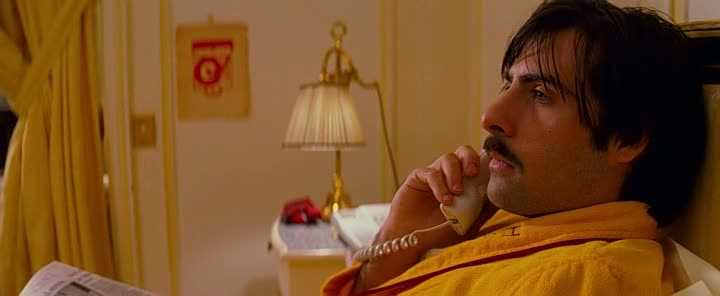 We switch immediately into a close-up shot, showing his facial features – while still somehow relaxed and expressionless – freeze
in place. We know that something is wrong. Mr. Whitman does not even answer to her “hello”, but apparently she knows him well enough
or can tell from his heavy breathing that he's there. Everything we need to, at this point, know about the relationship between him
and the female caller is condensed into the pause he makes before telling her his room number. From this we know that the relationship
between the two must be an intimate but damaged one. Obviously, the woman wants to see him and he would rather not see her. But there
must still be an intimate connection between the two, because he simply can't manage to tell her: no.
We switch immediately into a close-up shot, showing his facial features – while still somehow relaxed and expressionless – freeze
in place. We know that something is wrong. Mr. Whitman does not even answer to her “hello”, but apparently she knows him well enough
or can tell from his heavy breathing that he's there. Everything we need to, at this point, know about the relationship between him
and the female caller is condensed into the pause he makes before telling her his room number. From this we know that the relationship
between the two must be an intimate but damaged one. Obviously, the woman wants to see him and he would rather not see her. But there
must still be an intimate connection between the two, because he simply can't manage to tell her: no.
So at this point, already, I was pretty much hooked. I wanted to know who the mysterious woman was, of course, and what their relationship
was like, and what the hell Mr. Whitman is doing in this hotel room. I was hooked because of all the open questions, all of which were
basically laid bare by Mr. Whitmans strange reaction to the phone call. Hotel Chevalier, being no fool, does not tell us everything at once:
it keeps handing us bits and pieces, exposes some secrets, and makes us long for what more is to come.
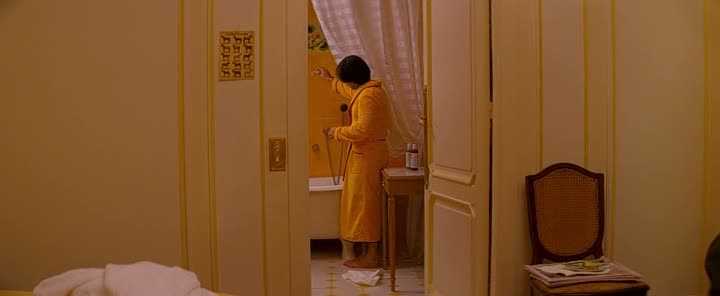 This is why I think we pay so much close attention to the following things Mr. Whitman does in preparation for the woman's arrival. He picks
up some of the clothes laying around. He starts filling up a bath with water. He takes a look in the mirror (and does not seem to excited
about the face greeting him therein). He switches the lights off and back on – probably testing out which “light mood” would best fit the
situation. He switches off the TV, of course.
This is why I think we pay so much close attention to the following things Mr. Whitman does in preparation for the woman's arrival. He picks
up some of the clothes laying around. He starts filling up a bath with water. He takes a look in the mirror (and does not seem to excited
about the face greeting him therein). He switches the lights off and back on – probably testing out which “light mood” would best fit the
situation. He switches off the TV, of course.
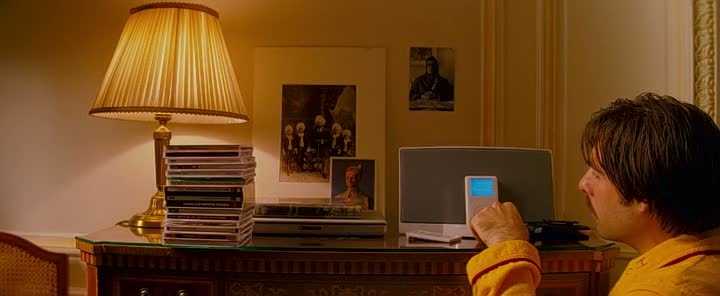 All of these are pretty normal preparations for when you're expecting a female guest. But Mr. Whitman even goes a little step further: He
unwraps a little statuette and places it neatly on a drawer. Then he goes to his iPod station and prepares the exact song he wants to play
while greeting her. Only then does he go back into the bathroom and takes of his bathrobe.
All of these are pretty normal preparations for when you're expecting a female guest. But Mr. Whitman even goes a little step further: He
unwraps a little statuette and places it neatly on a drawer. Then he goes to his iPod station and prepares the exact song he wants to play
while greeting her. Only then does he go back into the bathroom and takes of his bathrobe.
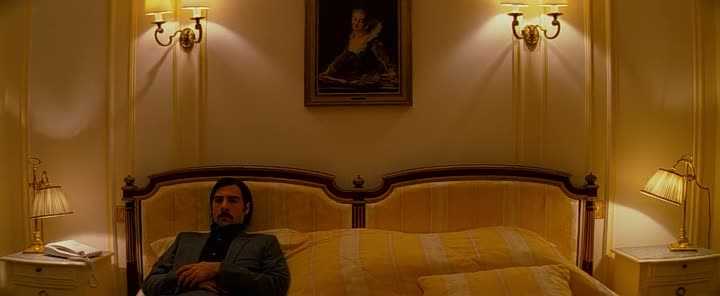 Then there's a time jump. We see Mr. Whitman in much the same position of the first shot. Only now the frame has been moved up a notch –
revealing less of the partner-less bed and instead framing one of those typical paintings that hang on the walls of low-upper class hotels.
And the most important change of couse is the suit Mr. Whitman is now wearing, waiting patiently and still pretty much without the whiff
of any certain facial expression.
Then there's a time jump. We see Mr. Whitman in much the same position of the first shot. Only now the frame has been moved up a notch –
revealing less of the partner-less bed and instead framing one of those typical paintings that hang on the walls of low-upper class hotels.
And the most important change of couse is the suit Mr. Whitman is now wearing, waiting patiently and still pretty much without the whiff
of any certain facial expression.
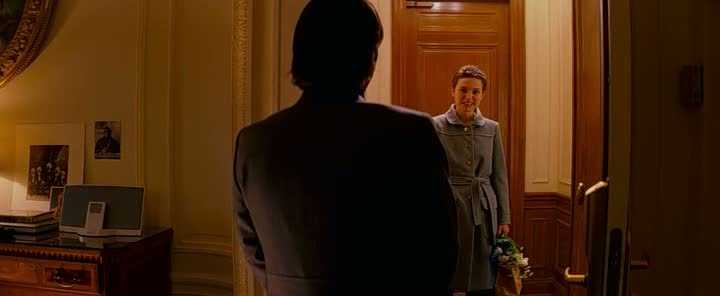 Finally, there's a knock on the door. Mr. Whitman moves out of frame to the door. The music starts playing and we know – even before the
camera catches up with his movements, that he's turned on the song he prepared earlier. And then we see her. She's talking on her cell phone
but then switches it off as soon as their eyes meet. She flashes a smirk at him, but then drops it because it probably was not answered by
any comforting gesture of Mr. Whitman. Instead, she asks him about the music which she seems to find out of place. The way they hug once again
confirm out earlier assumptions: she wants to kiss him – on the cheek, at least – but all he can manage is a long, possibly even cordial hug.
He wants to know how she found him – confirming further that he has in some way run away from her.
Finally, there's a knock on the door. Mr. Whitman moves out of frame to the door. The music starts playing and we know – even before the
camera catches up with his movements, that he's turned on the song he prepared earlier. And then we see her. She's talking on her cell phone
but then switches it off as soon as their eyes meet. She flashes a smirk at him, but then drops it because it probably was not answered by
any comforting gesture of Mr. Whitman. Instead, she asks him about the music which she seems to find out of place. The way they hug once again
confirm out earlier assumptions: she wants to kiss him – on the cheek, at least – but all he can manage is a long, possibly even cordial hug.
He wants to know how she found him – confirming further that he has in some way run away from her.
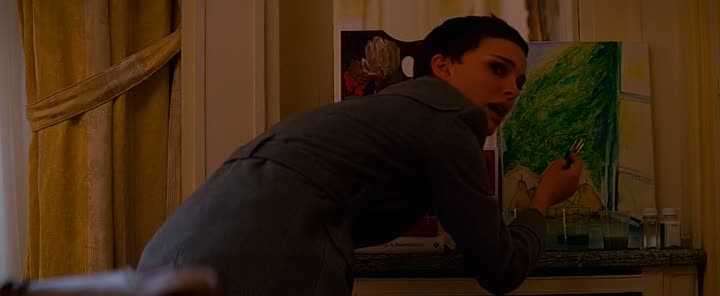 She evades any real answer and instead proceeds to examine his hotel room. At this point we realize that Mr.
Whitman went to extremes to tidy everything up. We see the statuette from the scene before, but along with
it several postcards, collectibles and even self-made paintings – all neatly put on display on desk and
drawer. She smiles at him, sort of like saying, “I love this playful side of yours.” But at this crucial
point, the viewer is ahead of her. He knows that the outer facade Mr. Whitman has erected within only half
an hour does not represent his current life very well. Everything is designed to trick her into believing that he's leading a happy life
without her. The song comments on this very directly (almost obtrusively) for the first time “I want to look inside your head, yes I do.”
She evades any real answer and instead proceeds to examine his hotel room. At this point we realize that Mr.
Whitman went to extremes to tidy everything up. We see the statuette from the scene before, but along with
it several postcards, collectibles and even self-made paintings – all neatly put on display on desk and
drawer. She smiles at him, sort of like saying, “I love this playful side of yours.” But at this crucial
point, the viewer is ahead of her. He knows that the outer facade Mr. Whitman has erected within only half
an hour does not represent his current life very well. Everything is designed to trick her into believing that he's leading a happy life
without her. The song comments on this very directly (almost obtrusively) for the first time “I want to look inside your head, yes I do.”
And this is, to me, the central theme of Hotel Chevalier: The possibility of looking inside somebody else's head. The woman wants to know what
Mr. Whitman's life has been like since they parted. So the first thing she does is examine his surroundings very closely. The way she tests the paint
of the still life on the drawer (while the song comments: “the painting you stole from Picasso”) seems to show that she's skeptical about this display,
but can't quite put her finger on what's wrong with it.
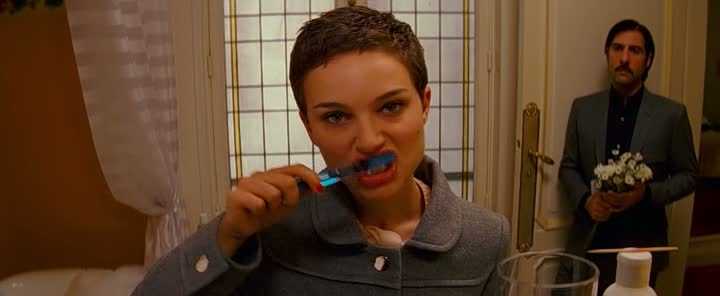 In the bathroom, the probing goes even further. She uses his toothbrush – sort of like they were still a couple where one can share such things.
She asks him about his haircut, which has apparently changed since they last saw each other. His answer Barbara in the lobby cut it reveals a further
clue that he does not leave his hotel much, not even to get a hair cut. There's a short irritation about the bath: We saw him fill it up more than
half an hour ago, expecting himself to take a bath – but now he states that he prepared it for her. This raises some eyebrows but is not resolved within the film plot.
In the bathroom, the probing goes even further. She uses his toothbrush – sort of like they were still a couple where one can share such things.
She asks him about his haircut, which has apparently changed since they last saw each other. His answer Barbara in the lobby cut it reveals a further
clue that he does not leave his hotel much, not even to get a hair cut. There's a short irritation about the bath: We saw him fill it up more than
half an hour ago, expecting himself to take a bath – but now he states that he prepared it for her. This raises some eyebrows but is not resolved within the film plot.
So even though only a couple of words have been spoken between him and her, we, as viewers, know just as much as we need to know about their relationship: we know that there's been hurt in the past, that he's run away from the situation, that he has put up a facade (possibly to take away her chances of hurting him even more?) and she's beginning to look through it. And we've discovered the main theme of ts film, so now we're excited to see whether the two will get a chance to look inside each other's heads or not.
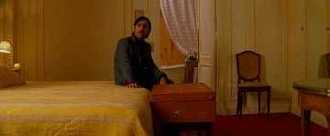

Finally, she simply asks “what the fuck is going on?”. She's not buying into all this crap. As we already know, Mr. Whitman is not one for simple questions
and answers, though. Instead of saying anything, he simply sits down on his bed. She sits down in the chair in the other room – so now there is a maximum
distance between the two – and tries another question. He's very vague on how long he's been staying in the hotel room, and once again succeeds in distracting
from the questions at hand by making her laugh. Up to this point, his defensive armor seems air-tight. When she discloses that she's planning on leaving
tomorrow morning, he does nothing more than take out a one-bite piece of hotel chocolate. No matter how directly she asks him questions (“are you running
away from me”), he finds a way of evading it ironically (“I thought I already did”).
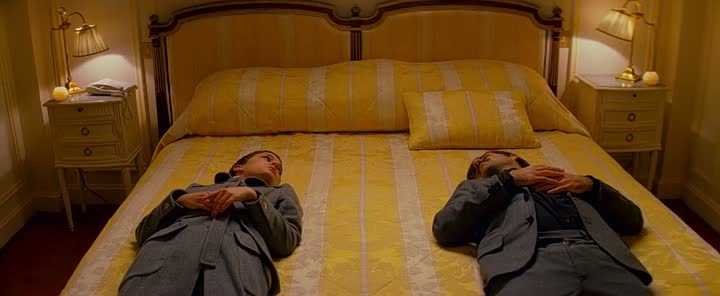 Despite all this, we keep sensing that there is a level of deep longing, maybe even deep understanding, for each other. Maybe they're both sorry for what
has happened in the past but both don't know how to undo the fatal knot that's been tied. I'm not quite sure why this feeling seems steadily present. Maybe
it has to do with the way she keeps smirking at him, or maybe the way she behaves like him (standing in front of the mirror like him when he was alone),
and quite probably the way they both let their bodies glide to the mattress just before the waiter arrives with lunch.
Despite all this, we keep sensing that there is a level of deep longing, maybe even deep understanding, for each other. Maybe they're both sorry for what
has happened in the past but both don't know how to undo the fatal knot that's been tied. I'm not quite sure why this feeling seems steadily present. Maybe
it has to do with the way she keeps smirking at him, or maybe the way she behaves like him (standing in front of the mirror like him when he was alone),
and quite probably the way they both let their bodies glide to the mattress just before the waiter arrives with lunch.
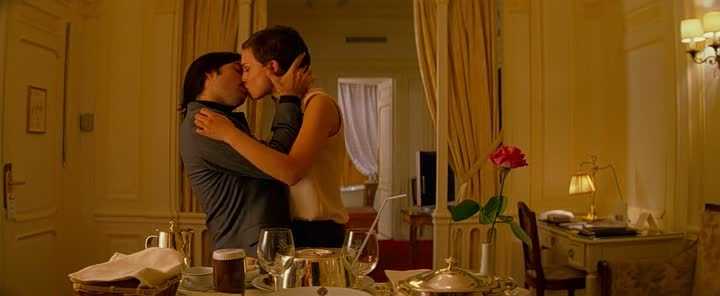 It's due to this feeling of compassion between the two that makes their rushed and intense kiss – right after the waiter has left – surprising but nonetheless
consistent. Or maybe we've just been hoping all along that they'll drop their standard routines and get down to some action.
It's due to this feeling of compassion between the two that makes their rushed and intense kiss – right after the waiter has left – surprising but nonetheless
consistent. Or maybe we've just been hoping all along that they'll drop their standard routines and get down to some action.
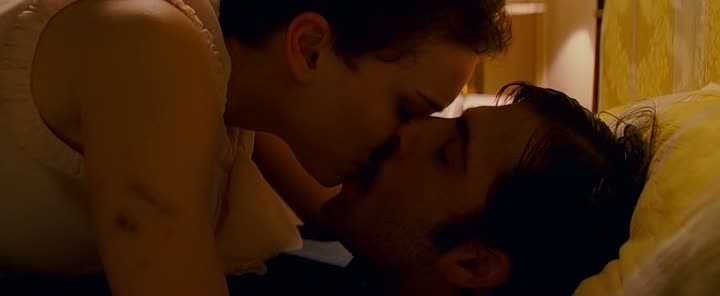 The ensuing undressing on the bed is all the more telling. They switch places like they know this choreography very well. While he does not even loosen a single
button of his suit – his protective armor – he undresses her completely, revealing bruises on her leg and arm. This is the first glimpse he seems to be getting
behind her solid facade. When he first sees them (“you've got bruises on you body”) is, to me, the first time he reveals any true emotion at all. So while she
is exposed, he himself tries to keep up his tough shell a little longer. There's the wonderfully ambivalent “I promise, I will never be your friend, no matter
what – ever” which just makes you stop and wonder: is this a promise the be her lover again (i.e. not “just” a friend) or a reiteration of his previous stance:
i.e. “I will not let you into my life again”). Even when she goes on to say that she loves him and never hurt him on purpose, his reply (“I don't care”) can
once again be taken as an utterance of forgiveness or of scorn.
The ensuing undressing on the bed is all the more telling. They switch places like they know this choreography very well. While he does not even loosen a single
button of his suit – his protective armor – he undresses her completely, revealing bruises on her leg and arm. This is the first glimpse he seems to be getting
behind her solid facade. When he first sees them (“you've got bruises on you body”) is, to me, the first time he reveals any true emotion at all. So while she
is exposed, he himself tries to keep up his tough shell a little longer. There's the wonderfully ambivalent “I promise, I will never be your friend, no matter
what – ever” which just makes you stop and wonder: is this a promise the be her lover again (i.e. not “just” a friend) or a reiteration of his previous stance:
i.e. “I will not let you into my life again”). Even when she goes on to say that she loves him and never hurt him on purpose, his reply (“I don't care”) can
once again be taken as an utterance of forgiveness or of scorn.
So does the film resolve these issues or not? Will the two get back together or not? My personal interpretation is that the film intentionally remains open
about this. It does something much more beautiful than to give easy answers: it opens our minds to the tiny nuances, the complexities, and the contradictions
of human relationships.
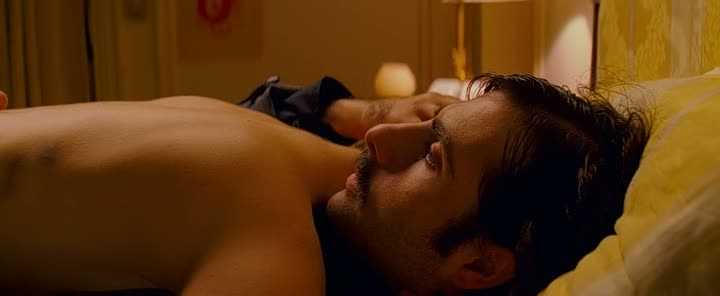 We don't learn specifically what caused the woman's bruises. We never find out what exactly she did to hurt him. We will never now whether they'll get back
together or not. Those were not, in retrospect, the questions the movie really set out to answer in the first place. The theme of the film is not whether a
loving couple will manage to resolve all the conflicts between them. The theme of the film is whether they will get a chance to look inside each other's head.
And this question, at least, is answered with a definite “yes”. She lets him see her bruises. And he, in return, does a very simple thing. He asks her if she
wants to see his view of Paris. In this startling moment, he drops all pretensions and simply invites her to see what his life is really like. And it's
certainly no coincidence that as he says this, her head disappears behind his head and it looks for a moment like she is “wearing” his head instead of her own!
We don't learn specifically what caused the woman's bruises. We never find out what exactly she did to hurt him. We will never now whether they'll get back
together or not. Those were not, in retrospect, the questions the movie really set out to answer in the first place. The theme of the film is not whether a
loving couple will manage to resolve all the conflicts between them. The theme of the film is whether they will get a chance to look inside each other's head.
And this question, at least, is answered with a definite “yes”. She lets him see her bruises. And he, in return, does a very simple thing. He asks her if she
wants to see his view of Paris. In this startling moment, he drops all pretensions and simply invites her to see what his life is really like. And it's
certainly no coincidence that as he says this, her head disappears behind his head and it looks for a moment like she is “wearing” his head instead of her own!
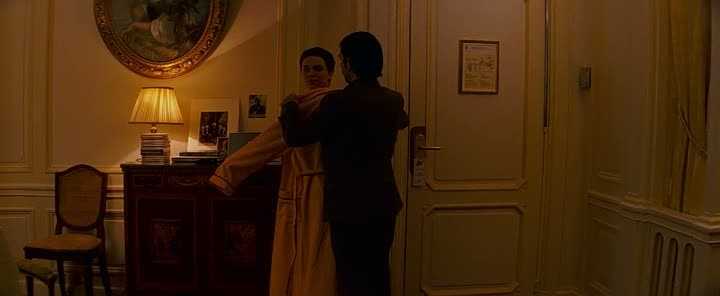 He dresses her in the very bathrobe he himself was wearing when he was alone in the hotel and simply takes her out onto the balcony. All this takes place in
slow motion – and as we take time to focus on their small gestures, witness his head turning to take one final glimpse at the hotel room that has been imprisoning
him, and once again pay close attention to the lines of the song (“You live in a fancy appartment […] But where do you go to my lovely, when you're alone in your
bed? Tell me the parts that surround you, I want to look inside your head”)
He dresses her in the very bathrobe he himself was wearing when he was alone in the hotel and simply takes her out onto the balcony. All this takes place in
slow motion – and as we take time to focus on their small gestures, witness his head turning to take one final glimpse at the hotel room that has been imprisoning
him, and once again pay close attention to the lines of the song (“You live in a fancy appartment […] But where do you go to my lovely, when you're alone in your
bed? Tell me the parts that surround you, I want to look inside your head”)
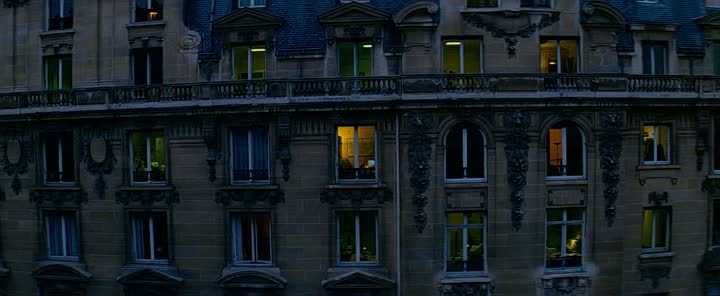
What she now sees, and what we see with her, is not a romantic setting of the Parisian skyline. It is, simply, a hotel wall. And by what we've come to know about Mr. Whitman, there can be no doubt that this, at last, truly is what it's like inside his head: He's in the middle of the city of love, but he's completely void of love. As void of love as the completely banal outer facade of a hotel room.
copyright 2009 - 2020 Richard Winter
Ideen, Anregungen, Kritik? Einfach ein Mail schicken an
richard@richardhwinter.de